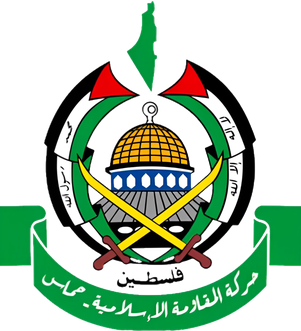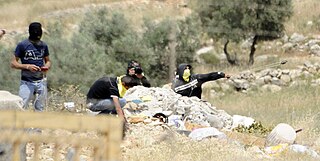Related Research Articles

The Gaza Strip, or simply Gaza, is a polity and the smaller of the two Palestinian territories. On the eastern coast of the Mediterranean Sea, Gaza is bordered by Egypt on the southwest and Israel on the east and north.

Hamas, an acronym of its official name, Harakat al-Muqawama al-Islamiya, is a Palestinian Sunni Islamist political and military movement governing parts of the Israeli-occupied Gaza Strip.

Zionist political violence refers to politically motivated violence or terrorism perpetrated by Zionists. The term is used to describe violence committed by those who support the political movement of Zionism, and violence committed against opponents of Zionism. The violence often takes the form of terrorist attacks and has been directed against both Jewish and Arab targets. The most active period of most notable Zionist political violence began on June 30, 1924, through the 1940s, and continues to the present day, usually for the purpose of expanding Zionist settlements in Mandatory Palestine.

Hugo Grotius, also known as Hugo de Groot or Huig de Groot, was a Dutch humanist, diplomat, lawyer, theologian, jurist, statesman, poet and playwright. A teenage prodigy, he was born in Delft and studied at Leiden University. He was imprisoned in Loevestein Castle for his involvement in the controversies over religious policy of the Dutch Republic, but escaped hidden in a chest of books that was transported to Gorinchem. Grotius wrote most of his major works in exile in France.

The First Intifada, also known as the First Palestinian Intifada or the Stone Intifada, was a sustained series of protests, acts of civil disobedience and riots carried out by Palestinians in the Israeli-occupied Palestinian territories and Israel. It was motivated by collective Palestinian frustration over Israel's military occupation of the West Bank and the Gaza Strip, as it approached a twenty-year mark, having begun in the wake of the 1967 Arab–Israeli War. The uprising lasted from December 1987 until the Madrid Conference of 1991, though some date its conclusion to 1993, with the signing of the Oslo Accords.

The Second Intifada, also known as the Al-Aqsa Intifada, was a major uprising by Palestinians against the Israeli occupation, characterized by a period of heightened violence in the Palestinian territories and Israel between 2000 and 2005. The general triggers for the unrest are speculated to have been centered on the failure of the 2000 Camp David Summit, which was expected to reach a final agreement on the Israeli–Palestinian peace process in July 2000. An uptick in violent incidents started in September 2000, after Israeli politician Ariel Sharon made a provocative visit to the Al-Aqsa compound, which is situated atop the Temple Mount in East Jerusalem; the visit itself was peaceful, but, as anticipated, sparked protests and riots that Israeli police put down with rubber bullets, live ammunition, and tear gas. Within the first few days of the uprising, the IDF had fired one million rounds of ammunition.
A civilian is a person not a member of an armed force nor a person engaged in hostilities.
A preemptive war is a war that is commenced in an attempt to repel or defeat a perceived imminent offensive or invasion, or to gain a strategic advantage in an impending war shortly before that attack materializes. It is a war that preemptively 'breaks the peace' before an impending attack occurs.
International humanitarian law (IHL), also referred to as the laws of armed conflict, is the law that regulates the conduct of war. It is a branch of international law that seeks to limit the effects of armed conflict by protecting persons who are not participating in hostilities and by restricting and regulating the means and methods of warfare available to combatants.

The Fatah–Hamas conflict is an ongoing political and strategic conflict between Fatah and Hamas, the two main Palestinian political parties in the Palestinian territories, leading to the Hamas takeover of the Gaza Strip in June 2007. The reconciliation process and unification of Hamas and Fatah administrations remains unfinalized and the situation is deemed a frozen conflict.
Targeted killing, or assassination is a tactic that the government of Israel has used during the Israeli–Palestinian conflict, the Iran–Israel proxy conflict, and other conflicts.
The international community considers the establishment of Israeli settlements in the Israeli-occupied territories illegal on one of two bases: that they are in violation of Article 49 of the Fourth Geneva Convention, or that they are in breach of international declarations. The United Nations Security Council, the United Nations General Assembly, the International Committee of the Red Cross, the International Court of Justice and the High Contracting Parties to the Convention have all affirmed that the Fourth Geneva Convention applies to the Israeli-occupied territories.

China–Palestine relations, also referred to as Sino–Palestinian relations, encompasses the long bilateral relationship between China and Palestine dating back from the early years of the Cold War.

Targeted killing is a form of assassination carried out by governments outside a judicial procedure or a battlefield.

Lethal autonomous weapons (LAWs) are a type of autonomous military system that can independently search for and engage targets based on programmed constraints and descriptions. LAWs are also known as lethal autonomous weapon systems (LAWS), autonomous weapon systems (AWS), robotic weapons or killer robots. LAWs may operate in the air, on land, on water, underwater, or in space. The autonomy of current systems as of 2018 was restricted in the sense that a human gives the final command to attack—though there are exceptions with certain "defensive" systems.

Palestinian stone-throwing refers to a Palestinian practice of throwing stones at people or property. It is a tactic with both a symbolic and military dimension when used against heavily-armed troops. Proponents, sympathizers, as well as analysts have characterized stone throwing by Palestinians as a form of "limited", "restrained", "non-lethal" violence. The majority of Palestinian youths engaged in the practice appear to regard it as symbolic and non-violent, given the disparity in power and equipment between the Israeli forces and the Palestinian stone-throwers, with many considering it a method of deterring Israeli military forces and civilians from the occupation of Palestinian lands. The state of Israel considers the act to be criminal, on the grounds that it is potentially lethal. In some cases, Israelis have argued that it should be treated as a form of terrorism, or that, in terms of the psychology of those who hurl stones, even in defense or in protest, it is intrinsically aggressive.
Black Sunday, 1937 refers to a series of acts undertaken by Jewish militants of the Irgun faction against Arab civilians on 14 November 1937. It was among the first challenges to the Havlagah policy not to retaliate against Arab attacks on Jewish civilians.

The West Bank, including East Jerusalem, has been under military occupation by Israel since 7 June 1967, when Israeli forces captured the territory, then ruled by Jordan, during the Six-Day War. The status of the West Bank as a militarily occupied territory has been affirmed by the International Court of Justice and, with the exception of East Jerusalem, by the Israeli Supreme Court. The official view of the Israeli government is that the laws of belligerent occupation do not apply to the territories, which it considers instead "disputed", and it administers the West Bank, excepting East Jerusalem, under the Israeli Civil Administration, a branch of the Israeli Ministry of Defense. Considered to be a classic example of an "intractable conflict", the length of Israel's occupation was already regarded as exceptional after two decades, and is now the longest in modern history. Israel has cited several reasons for retaining the West Bank within its ambit: a claim based on the notion of historic rights to this as a homeland as claimed in the Balfour Declaration of 1917; security grounds, both internal and external; and the deep symbolic value for Jews of the area occupied.
In international humanitarian law and international criminal law, an indiscriminate attack is a military attack that fails to distinguish between legitimate military targets and protected persons. Indiscriminate attacks strike both legitimate military and protected objects alike, thus violating the principle of distinction between combatants and protected civilians. They differ from direct attacks against protected civilians and encompass cases in which the perpetrators are indifferent as to the nature of the target, cases in which the perpetrators use tactics or weapons that are inherently indiscriminate, and cases in which the attack is disproportionate, because it is likely to cause excessive protected civilian casualties and damages to protected objects.
References
- 1 2 3 ICRC 2018, p. 18.
- 1 2 Chairman of the Joint Chiefs of Staff (11 August 2011). Joint Publication 3-0, Joint Operations (PDF). Washington, DC: US Government Printing Office. pp. A–1 – A–4. Archived from the original (PDF) on 3 March 2016. Retrieved 22 June 2021.
- ↑ White 2007, p. 17.
- ↑ Moore, Wendy. "Hugo Grotius: Later Career (Timeline of Huig de Groot, known as Hugo Grotius)". libguides.law.uga.edu. Retrieved 2021-06-26.
- 1 2 3 Levie, Howard S. (1977). "Combat Restraints". Naval War College Review. 29 (3): 61–69. ISSN 0028-1484. JSTOR 44641720.
- ↑ Mallick, P K (2009). "Principles of War: Time for Relook" (PDF). Centre for Land Warfare Studies (CLAWS), New Delhi. Manekshaw Paper No. 12. Retrieved 22 June 2021.
- 1 2 O'Brien, William V. (1981). "Normative and Policy Restraints on War". Michigan Law Review. 79 (4). Reviewed Works: Restraints on War: Studies in the Limitation of Armed Conflict edited by Michael Howard; Humanitarian Politics: The International Committee of the Red Cross by David P. Forsythe.: 991–1009. doi:10.2307/1288329. ISSN 0026-2234. JSTOR 1288329.
- ↑ Dasgupta, Sunil (10 April 2010). "The Fate of India's Strategic Restraint". Brookings. Retrieved 2021-06-21.
[...] the disconnect between strategic purpose and military planning is both shaped by and reinforces military-strategic restraint in India's foreign policy [...]
- 1 2 ICRC 2018, p. 19.
- 1 2 Joseph Federici; Melissa Dalton (30 November 2017). "Operational Security, Accountability, and Civilian Casualties". Center for Strategic and International Studies. Retrieved 2021-06-19.
- 1 2 ICRC 2018, p. 29.
- ↑ ICRC 2018, p. 25.
- ↑ ICRC 2018, p. 21.
- ↑ ICRC 2018, p. 20.
- ↑ Green 2018, p. 1-3.
- ↑ White 2007, p. 19, 23.
- ↑ Ganguly, Sumit; Kapur, S. Paul (2019-06-18). "The Myth of Indian Strategic Restraint". The National Interest. Retrieved 2021-06-22.
- ↑ Joshi, Shashank (27 September 2016). "India's strategic restraint on Kashmir". Lowy Institute. The Interpreter. Retrieved 2021-06-22.
- ↑ Singh, Tavleen (2016-10-07). "Fifth column: No more strategic restraint". The Indian Express. Retrieved 2021-06-22.
- ↑ Mehta, Ashok K. (10 March 2019). "India Has Clearly Abandoned Its Policy of Strategic Restraint". The Wire. Retrieved 2021-06-22.
- ↑ Fair, C. Christine (27 February 2019). "Indian millennials, fed on a post-Kargil diet, don't want strategic restraint with Pakistan". The Print. Retrieved 23 June 2021.
- ↑ Ron, James (2000). "Savage Restraint: Israel, Palestine and the Dialectics of Legal Repression". Social Problems. 47 (4): 445–472. doi:10.2307/3097130. ISSN 0037-7791. JSTOR 3097130.
Bibliography
- Green, Amelia Hoover (2018). The Commander's Dilemma: Violence and Restraint in Wartime. Cornell University Press. ISBN 978-1-5017-2648-4.
- ICRC (18 June 2018). "The Roots of Restraints in War" (PDF). International Committee of the Red Cross. Retrieved 21 June 2021.
The Roots of Restraint in War is an update of the 2004 Roots of Behaviour in War. Based on two years of research collaboration between the ICRC and six distinguished scholars [...]
- White, Stuart (Summer 2007). "A Paper Shield: Continuity and Failure in the Restraint of War" (PDF). Canadian Military Journal. 8 (2): 17–24.